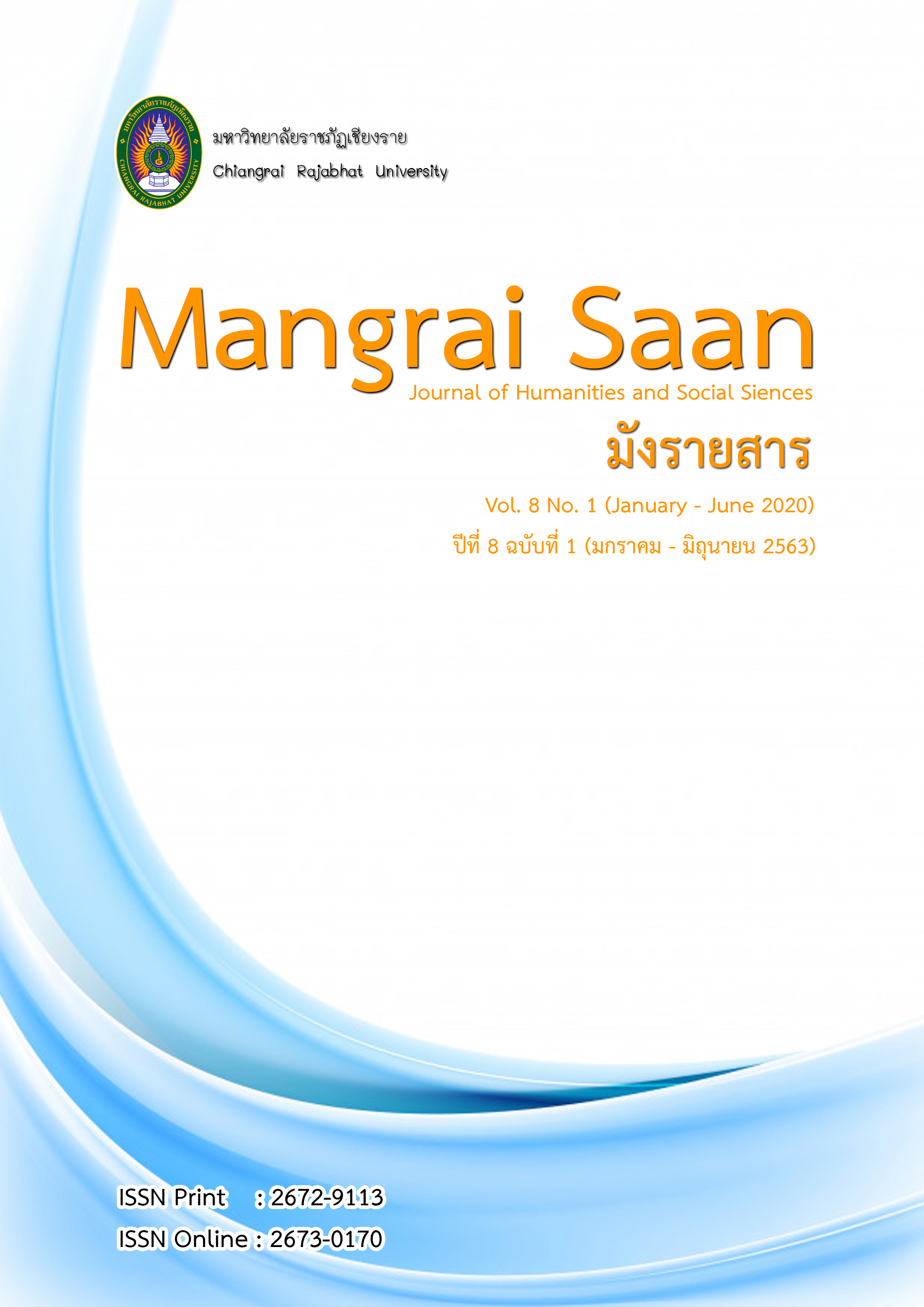Teacher’s Perceptions towards Authenticity and the Development of Learner Autonomy: Cases of Thai as a Foreign Language
Main Article Content
บทคัดย่อ
Authenticity in foreign language education has been widely advocated by scholars due to its pedagogical attributes to the learners’ language learning development. To the teachers’ perspectives, authenticity remains debatable if complexity and challenges would hinder the learners’ comprehension or increase learning motivation and learner autonomy. This article focuses on a qualitative study that investigated the teachers’ perceptions towards the use of authentic teaching materials and the development of learner autonomy among students of Thai as a foreign language at an institution of higher education in Singapore. Qualitative data collected through classroom observations, inspection of documentation and open-ended questionnaire were analysed. The results of the analysis suggest that authentic materials play an important role in increasing the learners’ interest and motivation, whereby the development of learner autonomy is enhanced. The key to these development lies in the support from the teachers and pedagogical tasks which help scaffold learners’ learning progress and outcomes. It is suggested that future research could explore perceptions of authenticity by learners and how they align with or differ from that of the teachers.
Article Details
เนื้อหาและข้อมูลในบทความที่ลงตีพิมพ์ในวารสารมังรายสาร ถือเป็นข้อคิดเห็นและความรับผิดชอบของผู้เขียนบทความโดยตรงซึ่งกองบรรณาธิการวารสาร ไม่จำเป็นต้องเห็นด้วย หรือร่วมรับผิดชอบใดๆ
บทความ ข้อมูล เนื้อหา รูปภาพ ฯลฯ ที่ได้รับการตีพิมพ์ในวารสารมังรายสาร ถือเป็นลิขสิทธิ์ของวารสารมังรายสาร หากบุคคลหรือหน่วยงานใดต้องการนำทั้งหมดหรือส่วนหนึ่งส่วนใดไปเผยแพร่ต่อเพื่อกระทำการใดๆ จะต้องได้รับอนุญาตเป็นลายลักอักษรณ์จากวารสารมังรายสารก่อนเท่านั้น
เอกสารอ้างอิง
Akbari, O., & Razavi, A. (2015). Using authentic materials in the foreign language classrooms: Teachers’ perspectives in EFL classes. International Journal of Research Studies in Education, 5(2).
BBC (2017). Get the news in your language. BBC News. Retrieved June 5, 2017 from http://www.bbc.co.uk/ws/languages
Berardo, S. A. (2006). The use of authentic materials in the teaching of reading. The reading matrix, 6(2).
Breen, M. P. (1985). Authenticity in the Language Classroom*. Applied Linguistics, 6(1), 60-70.
Clavel-Arroitia, B., & Fuster-Márquez, M. (2014). The authenticity of real texts in advanced English language textbooks. ELT journal, 68(2), 124-134.
Cross, D. (1984). News and activity in the media. In B. Jones (ed.), Using authentic resources in teaching French. London: Centre for Information on Language Teaching and Research, 19–28.
Davison, G. (2009). Developing Learner Autonomy through Authentic Assessment: Possibilities, Problems and Potential [PowerPoint Slides]. Retrieved from https://www.northumbria.ac.uk/static/powerpoint/ar/CarlislePowPot.ppt
Dickinson, L. (1987). Self-instruction in language learning. Cambridge, UK: Cambridge University Press.
Dueck-Stefánsson, N. M. (2015). The authenticity of reading materials provided for students in secondary school classrooms in Iceland.
Gajšt, N. (2014). Combining Learner Autonomy and Authentic Written Texts for the Acquisition of Business English Terminology. Journal of NELTA, 18(1-2), 65-76.
Gilmore, A. (2007). Authentic materials and authenticity in foreign language learning. Language Teaching, 40(2), 97-118.
Gulikers, J. T., Kester, L., Kirschner, P. A., & Bastiaens, T. J. (2008). The effect of practical experience on perceptions of assessment authenticity, study approach, and learning outcomes. Learning and Instruction, 18(2), 172-186.
Hampel, R. (2010). Task design for a virtual learning environment in a distance language course. In M. Thomas & H. Reinders (Eds.), Task-based language learning and teaching with technology (pp. 131-153). London, UK: Continuum International Publishing Group.
Holec, H. (1981). Autonomy and foreign language learning. Oxford: Pergamon.
Karnchanachari, S. (2020). Promoting communicative self-efficacy and a positive attitude towards English language learning through a collaborative authentic task. LEARN Journal: Language Education and Acquisition Research Network, 13(1), 210.
Khaniya, T. R. (2006). Use of authentic materials in EFL classrooms. Journal of NELTA, 11(1-2).
Kienbaum, B. E., A. J. Russell & S. Welty (1986). Communicative competence in foreign language learning with authentic materials: Final project report. Washington: Centre for International Education, Purdue University.
Kilickaya, F. (2004). Authentic materials and culture content in EFL classrooms. The Internet ELT Journal, 10(7).
Kung, F.-W. (2017). Teaching second language reading comprehension: the effects of classroom materials and reading strategy use. Innovation in Language Learning and Teaching, 13(1), 93–104.
Latifi, M., Youhanaee, M., & Mohammadi, E. (2013). Simplifying the text or simplifying the task: How to improve listening comprehension. Porta Linguarum (19), 7-21
Leaver, B. L., & Willis, J. (2005). Task-based instruction in foreign language education: Practices and programmes. Washington, DC: Georgetown University Press.
Lee, L. (2010). Fostering reflective writing and interactive exchange through blogging in an advanced language course. ReCALL, 22(2), 212–227
Lee, L. (2016). Autonomous learning through task-based instruction in fully online language courses. Language Learning & Technology, 20(2), 81–97. Retrieved from http://llt.msu.edu/issues/june2016/lee.pdf
Mills, N. (2009). A Guide du Routard Simulation: Increasing Self-Efficacy in the Standards Through Project-Based Learning. Foreign Language Annals, 42(4), 607–639.
Peacock, M. (1997). The effect of authentic materials on the motivation of EFL learners. ELT Journal, 51(2), 144–156.
Punch, K. F. (2005). Introduction to social research- quantitative and qualitative approaches. London: Sage Publications.
Richards, J. C. (2001). Curriculum Development in Language Teaching. Cambridge: Cambridge University Press.
Shirai, A. (2013). Authentic or Artificial Materials: The Effects of Material-Types on L2 Motivation. Chinese Journal of Applied Linguistics, 36(4), 422-441.
Tamo, D. (2009). ‘The use of authentic materials in classrooms’. Linguistic and Communicative Performance Journal 2/1: 74-8.
Tomlinson, B. (2001). Materials development. In R. Carter & D. Nunan (Eds.), The Cambridge Guide to Teaching English to Speakers of Other Languages (The Cambridge Guides, pp. 66-71). Cambridge: Cambridge University Press.
Tsou, W., & Chen, F. (2014). ESP program evaluation framework: Description and application to a Taiwanese university ESP program. English for Specific Purposes, 33, 39-53.
Wallace, C. (1992). Reading. Oxford: Oxford University Press.
Widdowson, H. G. (1978). Teaching Language as Communication. Oxford: Oxford University Press.
Widdowson, H. G. (1998). ‘Context, community, and authentic language’. TESOL Quarterly 32/4: 705-16.
Yin, R. K. (2018). Case study research and applications: Design and methods (6th Ed.). London: Sage Publications.
Zohoorian, Z. (2015). Motivation Level: A Study on the Effect of an Authentic Context. Procedia - Social and Behavioural Sciences, 192, 15-25.


